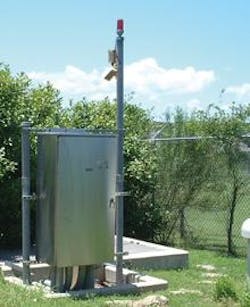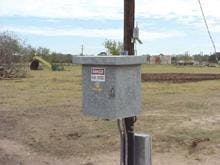New System Offers Lower Cost Wireless Monitoring
By Lee Blankenstein
Wireless remote monitoring using cellular control-channel technologies can help utilities collect data from remote sites that were once difficult or impossible to communicate with economically. New low-cost remote monitoring systems are available that transmit the information to a centralized Internet database, where data is stored on secure web pages for access by authorized users.
American Innovations offers a service that uses the control channels of the AMPS (Advanced Mobile Phone Service) cellular network. The control channels are used for data transmission and are different from the "talk channels" of a network. The control channels transmit data only and are part of the billing system used by the wireless carriers, so they have robust data handling capabilities.
An advantage of this type of system is that control channel radios can broadcast at the maximum radio frequency power allowed for a cell system, so coverage is often available in rural areas where voice channels may not work. Because of its far-reaching coverage, AMPS is the primary interface for automatic roaming and covers more than twice the geography of any other standard network.
The AMPS network also provides two-way connectivity, allowing operators to communicate with field devices. Since the system uses Internet protocols, applications can access devices through one TCP/IP based connection. Most data packets require only seconds to transmit data from a field device to the customer.
Cast Studies
Water Pipeline Rectifiers — A major pipeline company chose a remote wireless monitoring system to monitor its cathodic protection rectifiers because of the lower cost and ease of installation. No phone lines or electricity were required for the project.
"With 125 rectifiers, I had to find a remote monitoring system that was affordable," said a NACE certified Corrosion Technologist for the company. "The notification process is affordable as well. I can monitor the activity of each rectifier from my desk for very little money each month per unit.
"The rectifier interface is small enough to fit into the bottom of the rectifier enclosure. With a total of 6 wires, you can monitor volts, amps, and pipe-to-soil," he said.
Lift Stations — Because lift stations are often out of sight, they don't always receive the care and maintenance needed to keep them running smoothly. Water and wastewater operators need to know immediately if a pump fails, power is lost or an overflow is impending. Ken Moody, President of Moody Bros., a company providing instrumentation solutions for the water and wastewater industry, recommends remote wireless products to his customers for the monitoring of lift stations for several reasons.
"The number one reason we recommend instruments like these is that they can reduce costs," Moody said. "Operators and technicians can reduce their operations and maintenance times by responding to the real issues out there in the field. Alarm trends provide them with valuable operational data so they can correct problems before it's too late."
Tank Levels — Premier Chemicals is employing a remote monitoring system for tank level control. The city of Mission, located in the South Texas Rio Grande Valley, is using Premier's Thioguard product to stop odors by preventing the formation of hydrogen sulfide gas. A typical feed unit consists of a 2,500-gallon storage tank feeding from just a few gallons per day to several hundred gallons per day.
To monitor chemical usage, Premier coupled a wireless remote monitoring device with an ultrasonic level measuring transmitter and a digital controller. The transmitter senses the level of the Thioguard in the storage tank while the controller controls the flow from the tank and has a local digital display showing the gallons in the tank at any given time.
These devices are now standard components on all tanks of Thioguard. This approach ensures that the company's customers are properly supplied at all times, eliminating the need for a visit to check supply levels.
Conclusion
The use of cellular control channel technology and the Internet for monitoring remote sites has many positive attributes:
1. Easy to install: It is not necessary to run wires for power or communication.
2. Easy to use: Access to the data is web-based and notifications are sent automatically by fax, pager or electronic mail, so minimal training is required.
3. Low cost nation-wide communications: By using the excess capacity of the existing cellular control channel network, investment in communication infrastructure is eliminated.
4. Low cost network: Data is collected, managed and delivered via the Internet so investment in the network is minimal.
5. Secure access to information wherever and whenever you need it: Just log on to the Internet.
By using cellular control channel communication technology, water and wastewater companies now have the ability to collect data from remote sites that were once difficult or impossible to communicate with economically.
About the Author: Lee Blankenstein, PE, American Innovations, Austin, Texas USA


